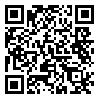Volume 17, Issue 1 (6-2019)
sjsph 2019, 17(1): 71-82 |
Back to browse issues page
Download citation:
BibTeX | RIS | EndNote | Medlars | ProCite | Reference Manager | RefWorks
Send citation to:



BibTeX | RIS | EndNote | Medlars | ProCite | Reference Manager | RefWorks
Send citation to:
Abdoli R, Sedaghat M M, Oshaghi M A, Edalat H, Telmadarraiy Z, Azarmi S et al . The Distribution of Hard Ticks as a Vector of Crimean-Congo Hemorrhagic Fever in the Border Areas in the North West of Iran. sjsph 2019; 17 (1) :71-82
URL: http://sjsph.tums.ac.ir/article-1-5736-en.html
URL: http://sjsph.tums.ac.ir/article-1-5736-en.html
Rahimeh Abdoli1 
 , Mohammad Mehdi Sedaghat2
, Mohammad Mehdi Sedaghat2 
 , Mohammad Ali Oshaghi3
, Mohammad Ali Oshaghi3 
 , Hamideh Edalat4
, Hamideh Edalat4 
 , Zakieh Telmadarraiy2
, Zakieh Telmadarraiy2 
 , Sahar Azarmi1
, Sahar Azarmi1 
 , Mohammad Javad Rafinejad *
, Mohammad Javad Rafinejad * 
 5
5

 , Mohammad Mehdi Sedaghat2
, Mohammad Mehdi Sedaghat2 
 , Mohammad Ali Oshaghi3
, Mohammad Ali Oshaghi3 
 , Hamideh Edalat4
, Hamideh Edalat4 
 , Zakieh Telmadarraiy2
, Zakieh Telmadarraiy2 
 , Sahar Azarmi1
, Sahar Azarmi1 
 , Mohammad Javad Rafinejad *
, Mohammad Javad Rafinejad * 
 5
5
1- MSc. Department of Medical Entomology and Vector Control, School of Public Health, Tehran University of Medical Sciences, Tehran, Iran
2- Ph.D. Asociate Professor, Department of Medical Entomology and Vector Control, School of Public Health, Tehran University of Medical Sciences, Tehran, Iran
3- Ph.D. Professor, Department of Medical Entomology and Vector Control, School of Public Health, Tehran University of Medical Sciences, Tehran, Iran
4- Ph.D. Assistant Professor, Department of Medical Entomology and Vector Control, School of Public Health, Tehran University of Medical Sciences, Tehran, Iran
5- Ph.D. Professor, Department of Medical Entomology and Vector Control, School of Public Health, Tehran University of Medical Sciences, Tehran, Iran ,jrafinejad@ tums.ac.ir
2- Ph.D. Asociate Professor, Department of Medical Entomology and Vector Control, School of Public Health, Tehran University of Medical Sciences, Tehran, Iran
3- Ph.D. Professor, Department of Medical Entomology and Vector Control, School of Public Health, Tehran University of Medical Sciences, Tehran, Iran
4- Ph.D. Assistant Professor, Department of Medical Entomology and Vector Control, School of Public Health, Tehran University of Medical Sciences, Tehran, Iran
5- Ph.D. Professor, Department of Medical Entomology and Vector Control, School of Public Health, Tehran University of Medical Sciences, Tehran, Iran ,
Abstract: (4361 Views)
Background and Aim: Ixodidae (hard ticks) are obligate blood-feeders of vertebrates with majorroles in transmission of pathogenic microorganisms including theileriosis, babesiosis and CCHF virus, as well as relapsing fever, to domestic animals and humans. This study was conducted to determine the distribution of ixodidae species, vectors of Crimean-Congo hemorrhagic fever (CCHF), in the border areas in North West of Iran.
Materials and Methods: This was a descriptive cross-sectional study conducted in Ahar and Kaliybar Counties, East Azarbaijan Province, Iran. Randomized cluster sampling was done in villages in the forest and mountainous regions. Ticks were isolated by forceps from the animals, kept in sampling tubes and transferred to the laboratory. Then the tick samples were identified using taxonomical keys.Results: A total of 2022 hard ticks were isolated from 1400 head of livestock (1000, 200, 180 and 20 head of sheep, goat, cow and buffalo, respectively). On the average, the infestation rate was 1.44 per head of cattle ─ 0.11% in goats, 0.32% in sheep, 0.90% in buffaloes, 9.25% cows. Out of the ticks isolated, 498 (24.63%) were male, 741 (36.65%) were female and 782 (38.67%) nymph, plus one larva. The ticks belonged to the lxodidae family, including four genera: Hyalomma (88.82%, with the following three species: Hyalommaanatolicum (39.22%), Hyalommamarginatum (9.15%) and Hyalommaasiaticum (0.69%)); Rhipicephalus (8.8%); Dermasentor (1.58%); and Haemaphisalis (0.8%). The others identified were Hyalomma nymph (38.67%), Hyalomma sp. (1.04%) and Hyalomma larva (0.05%), Rhipicephalus bursa (5.19%), Rhipicephalussanguineus (3.61%), Dermasentor marinates(1.58%), Haemaphisalissulcata (0.59%), and Haemaphisalispunctata (0.15%), as well as Haemaphisalisconcinae (0.05%). Hyalommaanatolicum was the dominant species.
Conclusion: The dominant tick species in the regions studied was Hyalommaanatolicum, a tick having a major role in transmission of many disease vectors including CCHF, ovin babesiosis, theileriosis, anaplasmosis, ehrlichiosis, etc. It is essential that the provincial Contagious Disease Center and Veterinary Department take appropriate action with the collaboration of other relevant departments to combat the tick.
Type of Study: Research |
Subject:
Public Health
Received: 2019/06/18 | Accepted: 2019/06/18 | Published: 2019/06/18
Received: 2019/06/18 | Accepted: 2019/06/18 | Published: 2019/06/18
Send email to the article author
| Rights and permissions | |
 |
This work is licensed under a Creative Commons Attribution-NonCommercial 4.0 International License. |



